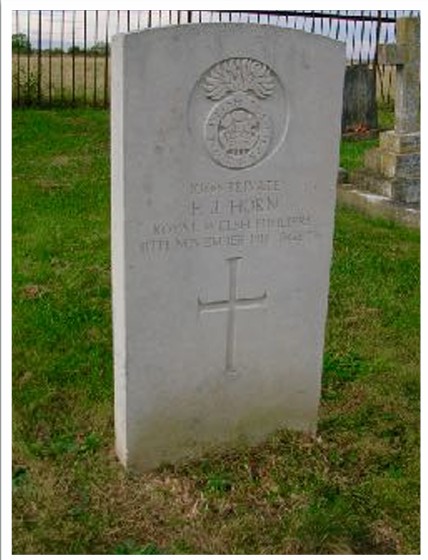1st Battalion, Royal Welsh Fusiliers

Frederick John Horn was a professional soldier, twice wounded and who died on Armistice Day, 11 November 1918.
He was born at Fairford in 1894, one of seven children born to Willoughby George Horn (1862-1932), an agricultural worker and his wife Mary (née Calcutt; 1860 -1930). Six of their children were surviving in 1911.
In 1901 Frederick lived with his family at Icomb, Gloucestershire, where his father was a cowman on a farm. By 1911 his parents had moved to Ablington, near Bibury: Frederick (age 16) was an under carter at a farm in Little Faringdon, Berkshire. Later the family home was at Clay Hill Farm, near Lechlade.
An Army Pension Record (APR) has survived for Frederick. This shows that he enlisted at Cirencester, on 7 November 1911. He stated his age to be 18 years, two months (when in fact he was probably a year younger) and his occupation as a carter (or waggon driver) on a farm. He undertook to serve at least seven years ‘with the Colours’ and a further five as part of the Reserve.
For reasons unknown, he joined the Royal Welsh Fusiliers (RWF), on 10 Wrexham at their depot in Wrexham. He remained at the Depot until 1 February 1912, after which he served in Dublin until 21 November of that year, as part of 1st Battalion. The next move was to Portland, Dorset, where he stayed until 10 January 1914. By now, having reached the age of 19, he was eligible for service abroad and his first posting was to Malta, where he remained until after the outbreak of the Great War. He left Malta on 3 September 1914 and on the 16th of that month arrived at Lyndhurst, Hampshire, where the battalion became part of 22 Brigade, 7 Division.
On 4 October 1914 the battalion sailed from Southampton to France but were diverted to Dover and then on to Zeebrugge in Belgium, arriving on the 6th. It journeyed by foot and train to near Ghent and then retired to Ypres, covering the Anglo-French retreat. On 19 October the battalion was located at Dadizeele, at the Menin-Roulers road crossroads. It mounted an attack on Klythoek under heavy shrapnel fire, without artillery support. Eventually it was forced to withdraw and was pulled back to Broodseinde. Eighty-four Other Ranks were wounded in the action and Private Horn was one of them. He was sent back to England on the 24th and remained there receiving treatment until his return to the Western Front on 26 January 1915 and a posting to the 2nd Battalion of the RWF, which was part of 19th Brigade, 6 Division. At that time the 2nd RWF was undertaking front line French duty in the Bois-Grenier area. On 13 February Frederick became ill with pneumonia and was sent, via a Field Ambulance, and No 14 General Hospital, Wimereux, back to England, arriving on 6 March 1915
He returned to the Western Front on 30 September, re-joining the 1st RWF. The battalion had sustained over 440 casualties on 25 September, attacking the German lines between Vermelles and Cite St Elie, during the Battle of Loos. No doubt he was part of a draft of replacements to make good the losses of the 25th. He was to remain with the 1st RWF, until he left the Western Front in July 1916.
On 15 July 1916 the Somme Offensive had been going for just over a fortnight and on that day the battalion was located near Bazentin-le-Petit. According to the battalion’s war diary it had been subjected to fairly continuous bombardment. On that day casualties amongst Other Ranks amounted to three killed, 21 wounded and one missing. According to his APR, on that day Frederick Horn suffered a gun shot wound to his spine (probably from shrapnel) and he was sent back to England on the 17th. He was admitted to the King George Military Hospital, Stamford Street, London SE, the largest military hospital in Britain at the time. The spinal injury had rendered him a paraplegic. On 22 November 1916 surgeons performed a laminectomy on his spine but this did not significantly improve his condition.
Now on the strength of the RWF Depot, on 7 March 1917 he was discharged from the Army ‘as no longer physically fit for war service’ and received his Silver War Badge, to denote his previous military service.
Frederick John Horn died at the Radcliffe Infirmary, Woodstock Road, Oxford on Armistice Day, 11 November 1918, aged 24. In the absence of sight of a death certificate the exact cause of death is not known. A recently released Pension Record Card simply sates that he died. It is possible that, as result of his injuries, his condition gradually deteriorated and/or he became a victim of the ‘Spanish Flu’ raging at the time.
He was buried in Lechlade Cemetery on 16 November 1918 and a standard CWGC headstone now marks h s grave. He is commemorated on the Memorial Tablet inside St Lawrence Church, Lechlade.
GRA
20 December 2020
